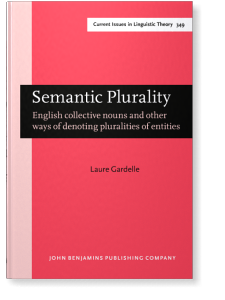Semantic plurality: English collective nouns and other ways of denoting pluralities of entities
This monograph proposes a comparative approach to all the ways of denoting ‘more than one’ entity, from collective and aggregate nouns (with the first-ever typology), to count plurals, partly substantivised adjectives and conjoined NPs. This semantic feature approach to plurality, which cuts across number, the count/non-count distinction, and lexical/NP levels, reveals a very consistent Scale of Unit Integration, which establishes clear-cut boundaries for collective nouns, and accommodates cases such as three elephant, cattle or a chain of islands. The study also offers a refined understanding of aggregate nouns (a category nearly as large as that of collective nouns) and quantification in pseudo-partitives, develops Guillaume’s notion of ‘internal plurality’, and proposes the innovative concept of ‘hyperonyms of plural classes’ (e.g. furniture). The Animacy Hierarchy is also found to be influential, beyond hybrid agreement. The book aims to be accessible to scholars of any theoretical background interested in these topics.
zum Buch im ULB-Katalog
zum Buch auf der Verlags-Website
Gender, the new woman, and the monster
This book views late Victorian femininity, the New Woman, and gender through literary representations of the figure of the monster, an appendage to the New Woman. The monster, an aberrant occurrence, performs Brecht’s “alienation effect,” making strange the world that she inhabits, thereby drawing veiled conclusions about the New Woman and gender at the end of the fin-de-siècle. The monster reveals that New Women loved one another complexly, not just as “friend” or “lover,” but both “friend” and “lover.” The monster, like the fin-de-siècle British populace, mocked the New Woman’s modernity. She was paradoxically viewed as a threat to society and as a role model for women to follow. The tragic suicides of “monstrous” New Women of color suggest that many fin-de-siècle authors, especially female authors, thought that these women should be included in society, not banished to its limits.
This book, the first on the relationship between the figure of the monster and the New Woman, argues that there is hidden complexity to the New Woman. Her sexuality was complicated and could move between categories of sexuality and friendship for late Victorian women, and the way that the fin-de-siècle populace viewed her was just as multifarious. Further, the narratives of her tragedies ironically became narratives that advocated for her survival.
zum Buch im ULB-Katalog
zum Buch auf der Verlags-Website
Weitere Titel können Sie in unseren Neuerwerbungslisten für die Anglistik entdecken!


